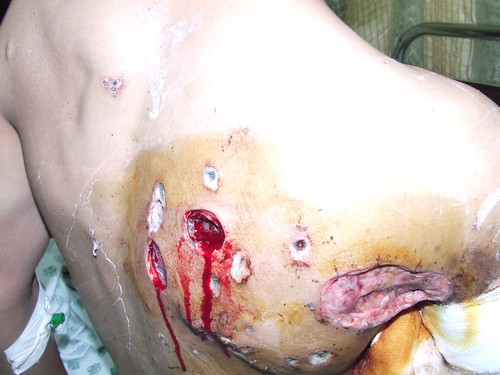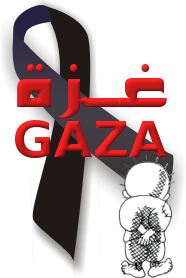
His sister, Alaa', 16, had been playing a game on her mobile phone. A third of her face was blown off, leaving part of her mouth, jaw and cheekbone missing. A massive part of her waist and pelvic area was destroyed with tissue loss exposing the bone. She was also badly burned. Medical staff at the Al-Nasser Hospital battled to save her and she pulled through 10 hours of surgery. She regained consciousness after the operation and wept when she heard about the death of her grandfather. However, five hours later she died suddenly.
It is time for Ayman's dressing to be changed. He cries out as the bandages are removed. A scarlet red wad of gauze is teased out of a deep hole in his back which it is filling in order to stem the bleeding. Five days after the attack, his wounds are still bleeding profusely. These are not normal burns. The wounds cover his upper back and right arm and his ankle has a deep wound down to the bone. He will need extensive plastic surgery. Shrapnel which entered Ayman's back penetrated one of his lungs and he has undergone surgery to repair several tears. He screams as iodine solution is applied. It is unbearable to watch his suffering.
Ayman is a civilian, a minor. He was at home with his family when they were attacked. Israel claims its bloody war has been on Hamas. Ayman, Alaa' and their grandfather were not Hamas operatives, neither were the thousands of other civilians killed and injured. Israel would call them "collateral damage". However, the atrocities committed against them amount to war crimes, especially if weapons have been used illegally. What exactly is the substance which has inflicted such wounds – not on Ayman alone but countless others also? Israel won't admit to the nature or composition of some of the less conventional weapons its military has been using on the population of Gaza.
Last night Israel declared a unilateral ceasefire. Following the ceasefire announcement, internally displaced people throughout the Gaza Strip went back to their neighbourhoods and homes to survey the damage. This was no different in Ayman's village, Khoza'a. Maher Abu Rejila, 22, a local farmer had gone to check on his home and his greenhouses. He was shot and killed by Israeli soldiers on the Green Line and his body was brought to the Al-Nasser Hospital today.
This is the true face of Israel's ceasefire. Now, under the shadow of Israeli troops on the border, F-16's still in the sky and gunboats still in the sea, Khoza'a, along with the rest of the Gaza Strip, is reeling from the Israeli onslaught. So many homes have been destroyed, leaving thousands with nowhere to go.
So many breadwinners killed or injured so badly they'll never work again. How will people survive? How will they re-build their lives?
Footage from Al-Nasser Hospital on 18th Jan
Photos from Al-Nasser Hospital on 18th Jan
http://www.flickr.com/photos/rafahkid/
(Warning: the above links contain graphic images)
Footage of unidentified incendiary substance found in Khoza'a
This footage was filmed in Khoza'a on 14th January. It shows an unidentified incendiary substance found on the ground next to a burnt-out home. It was still flaming from the previous day's incursion. It had to be buried to be extinguished, yet instantly re-ignited when it was uncovered again. These characteristics are consistent with those of white phosphorous.




No comments:
Post a Comment